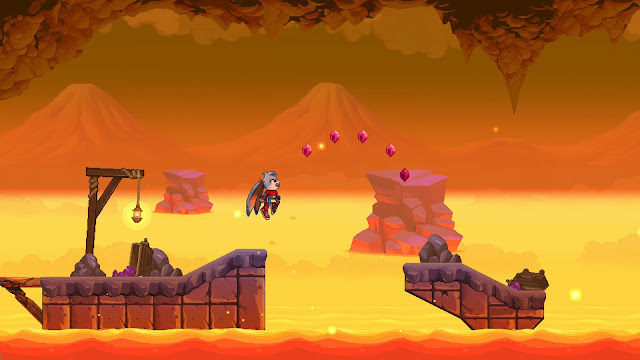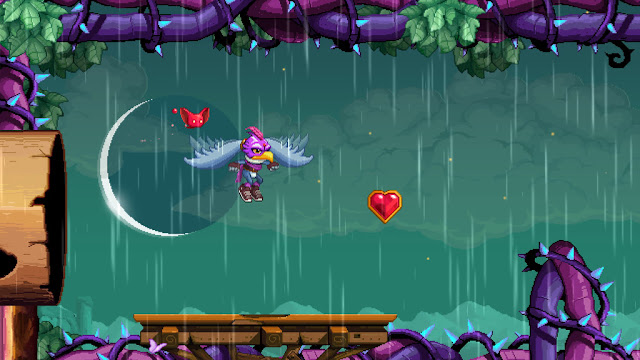Producing a homage to a great work of art, no matter the field, is noble. Doing so allows you to explore the qualities that made that artwork great, and draw attention to the ideas within it that you, as your own artist, found so inspiring. Homages are how we iterate on great ideas to elevate them even further. The problem is that a good homage is if anything, more difficult to produce than a completely original work, because you’ve still got to make it your own. Otherwise you end up with a pastiche. And pastiches are generally not considered to be good art. So let’s talk about Kaze and the Wild Mask, shall we?
The big problem that I have with reviewing Kaze is that I really enjoyed it. It’s well-made, challenging, bright and colourful. I enjoyed it so much, though, because I’ve already played Kaze many, many times now. There’s no effort whatsoever to disguise this: Kaze is Donkey Kong Country, particularly the original trilogy on the SNES, and while the developers are keen students and have absorbed everything that made Donkey Kong Country great in terms of presentation, design, and mechanics, they did miss the lesson about what really made Donkey Kong Country special; its own vivid, original creativity.
I’m going to need to talk about DKC briefly, because it’s relevant to the one big issue that I couldn’t get past with Kaze. To this day I remember the day that I first played Donkey Kong Country. It was a gift for my brother on his birthday, and it was a school day, so my parents woke us up early so we could play a little before being bundled off to class. I remember being absolutely mesmerised with that jungle level that first popped up, complete with the rhino to ride, the letters to collect, the little hidden rooms to find, and so on. I also remember that the very next level started introducing new gimmicks and entirely different “hook.” There was the level that was all about bounding on tires. There was a level about blasting from barrel to barrel. Later there were mine carts. There was a level with indestructible enemies that you could put to “sleep” temporarily by tapping a switch.
I remember thinking to myself “there’s no way this game can keep this up.” But it did. Donkey Kong Country became my favourite platformer of all time precisely because it never stopped finding new ways to give players something different to look at. I actually ended up playing it a whole lot more than my brother, but we were all sold on the series. Donkey Kong Country 2 and 3 were both, likewise, instant adds to our birthday and Christmas wish-lists.
Kaze’s biggest problem was that I was replaying every single trick from Donkey Kong Country, all over again. There was a near like-for-like recreation of the barrel blast level. There was an exact replica of that lights-on, lights-off level with the sleepy invincible enemies. You don’t ride animal buddies in Kaze, but instead you turn into them… and do the exact same thing as you did with the animal buddy levels in Donkey Kong Country The shark Kaze and the shark-riding levels of Donkey Kong Country are indistinguishable from one another. Hell, you’re even collecting the exact same things, only this time the swirly letters that spelled out “K-O-N-G” now spell out “K-A-Z-E.”
Kaze has the same basic moveset as in the Kong games. He has the same slight sense of inertia as in those earlier SNES titles. The enemies look different – they’re all animated fruits and vegetables this time – and they look good, but they all behave the same way as the beavers and kremlings in the DKC series. Even the boss battles have the same basic structure. If there is anything that Kaze has going for it as an original element it’s that it’s harder. There aren’t lives this time around, just checkpoints and unlimited retries, and the developers seem to have taken advantage of the removal of a risk of a “game over” screen to up the difficulty further. It’s that or my reflexes and skill with platformers is fading in my old age. That is entirely possible too.
Even the music riffs on the classic tunes that Donkey Kong Country blasted out, setting the same kind of tone and ambience to go with the setting for each of the levels. Again, there’s nothing that’s inherently wrong in looking at those soundtracks and finding them inspiring, but it’s hard to enjoy such a derivative artwork on its own terms when it’s trying so, so hard to be like something else.
So I’m left in a conundrum with Kaze. It’s bad art, to be blunt. This game didn’t even teeter on the edge between homage and pastiche here. It leapt over it with great enthusiasm. I find it strange that the developers did that because across the board the talent that went into making this is evident. The art is great, the structure of the levels are spot-on. The challenge curve is fair and enjoyable. The character of Kaze himself is good. So why didn’t they throw some of their own ideas in there too? Was it a lack of confidence? A misunderstanding of what makes a great homage?
Either way, I’m settling on the score that I have because I can’t reward work that is this derivative. But despite the score I find this one an easy recommendation for certain players out there. Kaze is a genuinely well-made game and if you like Donkey Kong Country you’re going to like this one, if for no other reason than it’s something of a greatest hits of the best Donkey Kong Country levels. If we see a Kaze 2 (and I hope we will), and the developers show us a little of their own creative ideas in there, then we’ll be looking at some really high scores indeed.
– Matt S.
Editor-in-Chief
Find me on Twitter: @mattsainsb










